Sneak preview! This is an excerpt from Chapter 2 of my book-in-progress. In it, you will find out about the true flatlands and the true meaning behind June Seventeenth, a beloved summer holiday of my childhood that turned out to have an sinister history.

Maybe one has to grow up in a flat landscape to appreciate this kind of terrain. To live there year-round and see it transform from the grey and brown winter tones into the almost shocking burst of greens in the spring, which in northern Germany comes in March, when Vermont has barely entered mud season. And to take in the huge expanse of sky over the distant horizon beyond the fields and meadows and roads lined with poplars. And the clouds, along with the peculiar, ever-changing light and colors that filled the air. In the early years of the 20thcentury, a group of painters had settled in Worpswede, a village near my hometown of Bremen, and had made the clouds as much an object of their art as the land with its bogs and fens, the white bark and light green foliage of the
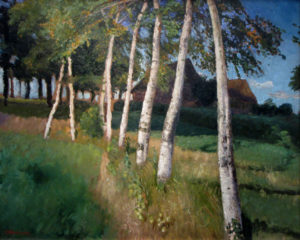
birches that lined the roads and creeks, and the people with their weather-beaten skin, who somehow coaxed a living from this land by cutting peatmoss and taking it to the city on their flat punts along the peatmoss canals. It was only through the digging of these canals in the 18thcentury that the waterlogged land around Worpswede had been made inhabitable. When I think of northern Germany, the paintings of the “Worpsweders[1]”come to my inner eye as much as the memory of the landscape itself.
It was in this landscape that I first learned to operate a bicycle. I must have been around five years old when my parents told me it was time to learn how to ride my bike without the support wheels. I doubted this, but agreed to give it a try. So I wobbled after my Dad on my children’s bike, out to the meadows on the other side of the Autobahn from our red-brick apartment building. He stopped on one of the little-used agricultural roads, took out the wrench from his bike’s repair kit, loosened the nuts from my bike’s training wheels, and placed them on the grassy edge of the road. I stood there straddling the bike, feeling off-balance without the steadying side wheels. “Don’t worry, the forward movement will keep you from falling. Trust me.” My Dad placed a hand on my back and started walking next to me, slowly at first but gradually picking up speed. I tried to keep my feet firmly on the pedals like he told me, and to have faith that I would not fall to one side or the other when he took his hand away. I must have managed a distance of a half dozen feet on my own the first time. We did it again, and again. “Gut so! Treten, treten” (pedal, pedal) he called out, and increasingly it seemed like this could work.
I don’t know how many miles my Dad ran alongside my children’s bike that day, or how much time we spent on that deserted road, but eventually we both felt reasonably confident that I could ride home without the support wheels. I could hardly wait to let my mother see this. When we turned the corner to our apartment block, she was looking out the kitchen window and clearly impressed by what she saw.
Chest swelled with pride, I reveled in my new self-reliance, not quite knowing yet that the bicycle – this one and many others to follow – would become my main mode of transportation for years and decades to come. My elementary school was close enough to walk to, but for the remainder of my school years the bicycle was the normal way my classmates and I would get to and from school. It was a matter of pride among us not to give in to rain or snow – people who couldn’t handle the weather were Softis and Weicheier (soft-boiled eggs).
The glorious flatland summers were the backdrop for countless family bicycle outings. 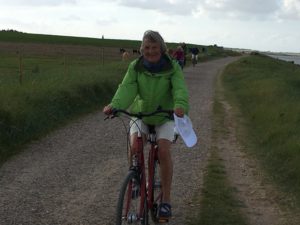 My Dad knew all the secret paths that would allow us to ride for miles and miles without encountering car traffic. Worpswede, the artists’ village, was a favorite destination, as was Fischerhude, where some of the artists had moved when the Worpswede years came to an end.
My Dad knew all the secret paths that would allow us to ride for miles and miles without encountering car traffic. Worpswede, the artists’ village, was a favorite destination, as was Fischerhude, where some of the artists had moved when the Worpswede years came to an end.
Any weekend day without pouring rain was fair game for a bike excursion, as was June Seventeenth, whether it fell on a weekend day or not. I knew that June 17 was a holiday, but thought of it simply as a summer holiday day on which everyone went on bike trips. 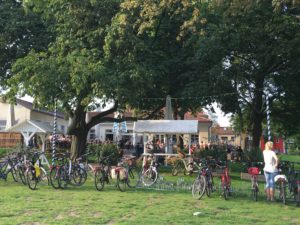 Only gradually did the true story behind this holiday creep up on me, as did the fact that it had a special name: Day of German Unity. This apparently had to do with the other Germany, the DDR. I also learned that June 17 was a holiday only in “our” Germany (the BRD[2]), and finally came to understand the occasion it was supposed to mark:
Only gradually did the true story behind this holiday creep up on me, as did the fact that it had a special name: Day of German Unity. This apparently had to do with the other Germany, the DDR. I also learned that June 17 was a holiday only in “our” Germany (the BRD[2]), and finally came to understand the occasion it was supposed to mark:
On June 17, 1953, there had been an uprising in the DDR that had been brutally beaten down. After that, West Germany had declared June 17 the “Day of German Unity” to remind its citizens of their fellow Germans in the DDR and of the clause in the West German basic law[3]that set forth the goal of reunification. As far as I could tell, though, few of my fellow West Germans were thinking about reunification or about the “other” Germans as we went about our bike excursions.
Pedaling along Mecklenburg Road now, the split reality of this former holiday hit me. On all those June Seventeenths when I was enjoying the summer breeze, a picnic, and perhaps a game of badminton on one of our bike trips, the people here in Mecklenburg-Western Pomerania and the rest of East Germany not only had a regular workday instead, but the memories of what had happened on that day in 1953. The memory of how their hopes for better living conditions and for some basic democratic rights had been dashed.
The unrest had begun on the morning of June 16, 1953, when workers at a factory in East Berlin demanded the lowering of production goals. A few days earlier, the East German government had raised those goals – effectively cutting the workers’ pay. Within moments of those workers starting their protest, they were joined by office workers, tram drivers, farmers, students, professors: People from all sectors of society dropped their work and expressed their frustration with the abysmal economic conditions, and soon also demanded free elections and other democratic rights.
I would have liked to ask an older person from around here how they had experienced June 17 and its aftermath. Had they participated in a protest? Had they known any of the dead or injured people? Had they believed in the ideals of socialism up to this day, and had they given up hope that their young country with the promising name “German Democratic Republic” could cultivate a socialist society without oppression?
But there was no one to ask. It occurred to me that I had seen very few people since I had briefly talked to the couple from Cologne at the boardwalk to the beach. This was not a densely populated area, and the reason lay close at hand: The phantom border I was tracing. On the eastern side, many people had been forcibly resettled if they were considered a “security risk” (i.e. suspected of wanting to escape). This suspicion had robbed some 11,000 people along the length of the border of their homes. On the western side, residents were struggling with the economic effects of the border[4]: Supply and distribution routes could only go in one direction – west; by the same token, customers could only come from that direction. Over the years, West Germany introduced a system of subsidies for communities along its side of the border – Zonenrandförderung– but this could not compensate for the entirety of the loss. Factories closed, jobs disappeared. And on both sides, people had to deal with the human dimension of the division: Families were separated; friends out of reach.
If I could not find anyone around here to ask about June 17, it occurred to me that I could ask my parents what they remembered of that day. It seemed strange to me now that I had never asked them this before, especially given that one of my favorite things as a child was to beg them to talk about “früher” (“way back,” by which I meant the time before my arrival in their lives). I pulled my bike over at a bench along Mecklenburg Road and dug my phone out of the handle bar pouch.
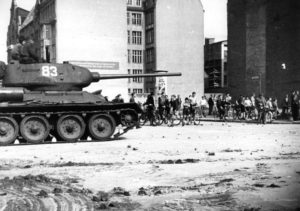
My Dad answered. I caught him up on my journey so far and told him I was thinking about June 17, and wondering what he had heard at the time about what was going on in East Germany that day in 1953. “It was awful,” he said. “I must have been fifteen at the time. I remember hearing about it on the radio, and seeing pictures in the newspaper. There were Soviet tanks, and throngs of people trying to block the tanks. The tanks didn’t stop, and there were soldiers shooting. There were dead people lying in the street. We didn’t have a TV at home – nobody I knew did – but it was graphic enough from the newspaper photos.”
“What about reunification? Do you think the June 17 holiday inspired people think about that?”
“Not much from what I remember. In the first few years after the War; there was so much immediate need. So much housing had been destroyed, so many refugees were coming in from the East[5], and so many men were missing – killed in the war, taken prisoner, or simply missing. The economy was in shambles; the infrastructure had to be rebuilt. By 1953, things were starting to look up in the BRD, but there was still a lot of work to do. Of course, conditions were much harder in the DDR[6].”
I had read about this. Parts of the Soviet-occupied zone of Germany (the zone that became the DDR/GDR) had been particularly dependent on imports from the eastern regions of pre-war Germany; regionsthat now belonged to Poland. And even though the Ostzonehad been affected less severely overall by bombing and war damage than the western zones[7], its industrial base was subject to Soviet reparation demands, which translated into the dismantling and removal of entire factories and rail lines. At the same time, East Germany did not benefit from the considerable financial shot in the arm of the European Recovery Plan. Originally conceived by George P. Marshall as a joint program financed by the Allied Powers, it was rejected by the Soviet Union because it was designed on the basis of a market economy rather than a state-controlled, centrally-planned economy. By this time in the summer of 1947, the ideological divisions between the Western Allies and the Soviet Union had already become pronounced, and set in motion the increasing economic divergence and political division of Germany, and Europe.
I remembered a cartoon I had seen, drawn in the early 1990s, after Unification. In four frames covering a span of the four decades of the division, an East German and a West German are each sitting in their living room. In the first frame, labeled “1950,” a thought bubble has both saying “Dear brother, I miss you so”. In the second one, labeled “1960,” the bubble says “Hi there, would be nice to meet for coffee sometime”. The third is labeled “1970” and says “Hope you’re doing alright” and the forth, in 1980, “Right, didn’t I have a distant cousin over there?” I thought that despite the obvious simplification, there probably was more than a kernel of truth to this depiction.
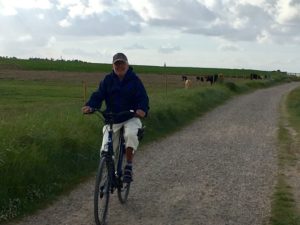 I thanked my Dad for sharing his memories, and he wished me a good journey onward. We didn’t spell out the fact that he would have been a perfect travel companion on my expedition, if it weren’t for his failing eyesight. Up until some ten years earlier, when he still had good vision in one eye and a small amount in the other, he had gone on several extended bike trips in various parts of Germany, some with my mother and some with friends from their Turnverein (sports club). In fact, one of these trips, in 2001, had been along the entire Baltic Coast almost to the Polish border. I was glad that he had taken these trips when his eyesight allowed, and thankful that he had offered his bicycle for my expedition. He still rode it close to home most days, on the secret paths he had known for decades, and I knew he would miss it. In a way, at least, he might feel like part of him was taking part in my expedition.
I thanked my Dad for sharing his memories, and he wished me a good journey onward. We didn’t spell out the fact that he would have been a perfect travel companion on my expedition, if it weren’t for his failing eyesight. Up until some ten years earlier, when he still had good vision in one eye and a small amount in the other, he had gone on several extended bike trips in various parts of Germany, some with my mother and some with friends from their Turnverein (sports club). In fact, one of these trips, in 2001, had been along the entire Baltic Coast almost to the Polish border. I was glad that he had taken these trips when his eyesight allowed, and thankful that he had offered his bicycle for my expedition. He still rode it close to home most days, on the secret paths he had known for decades, and I knew he would miss it. In a way, at least, he might feel like part of him was taking part in my expedition.
Footnotes
[1]Most importantly, the work of Otto Modersohn, Fritz Mackensen, Paula Modersohn-Becker, and Heinrich Vogeler.
[2]Bundesrepublik Deutschland (Federal Republic of Germany/FRG)
[3]The West German constitution
[4]More so than those on the eastern side, since they lived in a state-controlled, planned economy that was not predicated on a free market.
[5]From East Germany, but also from regions farther east that had been German before World War II but had been given to the Soviet Union and Poland at the end of the War. An estimated 12-14 million were expelled from those pre-war German territories in Eastern Europe and streamed into the remaining, much smaller (mostly West) Germany, with little but the clothes they were wearing.
[6]Deutsche Demokratische Republic (German Democratic Republic, East Germany’s official name)

Kerstin, this loving tribute to your Dad reminded me of a very similar moment in my life learning to ride a bike at about the same age that you were here. My Dad proceeded to teach me as yours did you. Thank you for reviving that memory.
Danke Cynthia!
Kerstin, finally a moment to explore your website. I just read the excerpt of your book and found it intriguing. German history from your insider’s point of view. I’d like to see more of this. Thank you!
Thank you Mary! I’m glad to hear you’d like to see more!